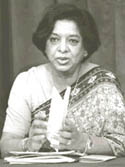
Nafis Sadik, Architect of ICPD
Date
December 1, 2000
Author

Nafis Sadik will retire at the end of this year from the UNFPA. Source: UN Photo 185585/ J. BU 1060L
This is the final installment in a series profiling people who have influenced thinking about population over the past century. A year’s worth of profiles could not do justice to all the people who deserve recognition. Our hope is that, by bringing you the insights of today’s population specialists on the contributions of their predecessors and contemporaries, we have personalized a century of population change and demographic work.
(Population Today, November/December 2000) Many people think of Nafis Sadik as the symbol of the remarkable new consensus that emerged from the International Conference on Population and Development (ICPD) in Cairo in 1994. This profile is an account of how Dr. Sadik helped make ICPD happen and why she deserves much of the credit for its success.
Nafis is an “in-from-the-field, up-through-the-ranks” leader with a masterful grasp of population issues. As a young doctor in Pakistan in the late 1950s, she taught rural women and men about family planning. She also helped develop the country’s first population policy as a member of the National Planning Commission. After joining the UN Population Fund (UNFPA) in its formative years, Nafis quickly rose to become director of operations, assistant executive director, and then executive director.
I have known Nafis since 1975. When I headed the U.S. Agency for International Development’s Office of Population in the early 1980s, she and I worked to minimize disruptions caused by the Reagan administration’s efforts to eliminate U.S. population assistance. I knew from the beginning that Nafis was an extremely able program manager; I learned later what a skillful diplomat she is.
In 1992, Nafis was named secretary-general of the ICPD. At that time, two political currents with profound implications for ICPD were flowing through the international community. The first was opposition to population policies that placed demographic objectives ahead of women’s health. The second was demand for a more active role for nongovernmental organizations (NGOs) in international political affairs. Nafis’ challenge was to channel both in a positive direction.
Rights advocates argued that demographic targets led to heavy-handed, even coercive, programs. Program administrators defended targets as necessary to keep program workers focused. Nafis, a longtime program administrator, was inclined to side with the latter. But as she listened to the impassioned voices of women, she changed her mind. When it was time to draft the conference document, her position was clear: The objective should be to serve individual needs. If that were done well, population growth would take care of itself. That point of view prevailed.
Representatives of international NGOs and foundations urged Nafis to open the ICPD to NGOs. Nafis at first hesitated but realized that civil society would not be denied a significant role in future global negotiations. She urged all governments to include NGO representatives in their delegations, and she supported an NGO presence throughout the ICPD process. In turning a political necessity into a virtue, Nafis also helped permanently change the role of civil society in international political conferences.
Perhaps Nafis’ most important contribution to ICPD was the introduction of global goals for the year 2015. Speaking before the final preconference meeting in April 1994, she proposed five 20-year goals: increased availability of family planning services; reduced infant mortality; reduced maternal mortality; increased life expectancy; and increased access to education, especially for girls and women. Her proposal demonstrated the interrelationship of key development goals: None could be achieved unless all were achieved.
ICPD culminated a distinguished career: from grassroots doctor to architect of one of the most successful international agreements of the last 30 years — certainly the most important in the history of the global population movement. While many deserve credit for the new ICPD orientation toward population and family planning, Nafis Sadik stands tallest because of her imagination, political skill, and leadership.
Steven Sinding is professor of clinical public health at Columbia University. He directed population programs at the Rockefeller Foundation from 1991 to 1999, and at the U.S. Agency for International Development from 1983 to 1986.
Articles in This Series
- Alfred Lotka, Mathematical Demographer
- Margaret Sanger, Birth Control Pioneer
- Alan F. Guttmacher, People’s Physician
- Gregory Pincus, Father of the Pill
- John D. Rockefeller 3rd, Statesman and Founder of the Population Council
- Reimert T. Ravenholt, USAID’s Population Program Stalwart
- Nafis Sadik, Architect of ICPD
